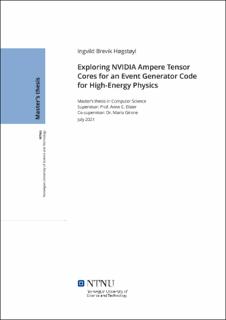| dc.contributor.advisor | Elster, Anne C. | |
| dc.contributor.advisor | Girone, Maria | |
| dc.contributor.author | Høgstøyl, Ingvild Brevik | |
| dc.date.accessioned | 2022-02-24T18:19:31Z | |
| dc.date.available | 2022-02-24T18:19:31Z | |
| dc.date.issued | 2021 | |
| dc.identifier | no.ntnu:inspera:74730513:21439137 | |
| dc.identifier.uri | https://hdl.handle.net/11250/2981318 | |
| dc.description.abstract | Det er en økende interesse og etterspørsel etter mer kosteffektive løsninger for hvordan en kan utnytte regneresursene til store HPC-systemer.
Datasentrene er tilbyr nå mer heterogen databehandling, som inkluderer systemer med akseleratorer , deriblant GPUer.
For å møte fremtiden databeregningsbehov jobber nå CERN med å tilby fler og fler heterogene systemer med GPUer for å få 'workloads' (arbeidsmengden deres applikasjoner utgjør) til å gå raskere, men også for å kunne utnytte all maskinvaren de har tilgjengelig via nettverket Worldwide LHC Computing Grid (WLCG).
Arbeidet i denne masteroppgaven inkluderer å finne en egnet 'workload'/applikasjon å kunne jobbe med. Vi endte opp med å fokusere på en del av MadGraphm en fysikk event-generator som det er planer om skal bli en del av benchmarking suiten til CERN, Event-generatorer forbruker mange regneressurser, og dere krav om beregningskraft er forventet å øke ytterligere i fremtiden ettersom eksperimentene de bygger på oppgraderes. | |
| dc.description.abstract | There is an increasing interest and demand for more cost-effective solutions for how to utilize the processing power of large HPC systems. Data centers are now progressively offering more heterogeneous computing, that include accelerators such as GPUs.
To meet the computational demands of the future, CERN is working on utilizing modern hardware such as GPUs, both to speed up their workloads, but also to utilize all the hardware they have available through the Worldwide LHC Computing Grid (WLCG).
The work of this thesis includes finding a suitable workload to work with. We landed on that the focus should be on the MadGraph workload, a physics event generator planned to be used as part of one of the benchmarking suites at CERN. Event generators are large consumers of CPU resources, and their computational cost is expected to increase with future upgrades of the experiments on which they are built.
Our works expands on the current GPU version of the workload which is a simple conversion of some of the parts of the CPU version. Many of the calculations in the code involve double precision complex numbers, over-utilizing the FP64 pipeline in the GPU, while under-utilizing the others. The work of this thesis therefore focuses on investigating whether the code can be optimized by using the new NVIDIA A100 GPU, which offers 64-bit floating point Tensor Cores.
The thesis also includes profiling resulkts from using Valgrind and KCachegrind on the CPU as well as results from using Nsight Systems and Nsigth Compute for profiling the GPU kernels. Integration the usage of Tensor Cores into the MadGraph GPU code and analysing the effect of the changes, as well as some suggestions for future work, are also included. | |
| dc.language | eng | |
| dc.publisher | NTNU | |
| dc.title | Exploring NVIDIA Ampere Tensor Cores for an Event Generator Code for High-Energy Physics | |
| dc.type | Master thesis | |
